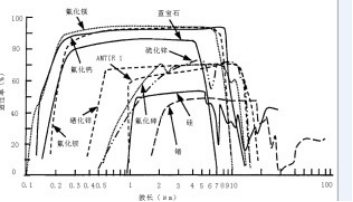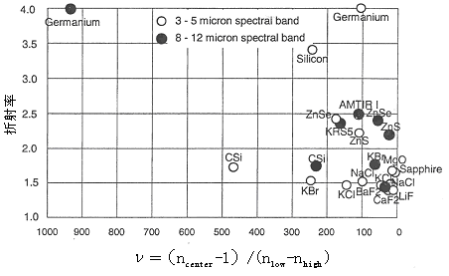2.2.1Characteristics of infrared optical materials
(1)Infrared materials are not only limited in variety, but also expensive (generally in several thousand to tens of thousands of yuan per kilogram).
(2)Some materials have a large refractive index temperature coefficient (DN/DT), resulting in a large focal length drift with temperature.If the operating temperature range is wide, it is necessary to choose the infrared optical materials appropriately or take necessary measures to compensate.
(3)Some optical materials are fragile, and poor chemical stability, making processing and installation difficult, the yield is not high.
(4)Many optical materials are opaque and show different colors depending on the material and band.
(5)When infrared optical materials are heated, they all radiate themselves, resulting in stray light.
Table 2-1 Characteristics of commonly used infrared optical materials
Material | Refractive Index(4μm) | Refractive Index(10μm) | dn/dt/℃ |
Ge | 4.0243 | 4.0032 | 0.000396 |
Silicon | 3.4255 | 3.4179 | 0.00015 |
ZnS(CVD) | 2.252 | 2.2005 | 0.0000433 |
ZnSe(CVD) | 2.4331 | 2.4065 | 0.00006 |
AMTIR I | 2.5141 | 2.4976 | 0.000072 |
MgF2 | 1.3526 | + | 0.00002 |
Sapphire | 1.6753 | + | 0.00001 |
CaF2 | 1.4097 | + | 0.000011 |
BaF2 | 1.458 | * | -0.000016 |

Figure 2.1 shows the transmittance of more commonly used infrared materials including surface loss.In practical application, coating and plating of high efficiency anti-reflection film can achieve quite high transmittance (95%-98%). The figure does not include ch4 glass Transmittance curve of.The average transmittance is greater than 65%, the fluctuation is less than 3%, and the loss is less than 2.4%/cm for the thickness of 1mm ch4 glass between 8-11μm.

The glass diagram of commonly used refractive inf![]() rared materials is shown in FIG. 2.2. The ordinate represents refractive index and the abscissa represents Abbe constant
rared materials is shown in FIG. 2.2. The ordinate represents refractive index and the abscissa represents Abbe constant
2.2.2Commonly used infrared optical materials
Germanium is one of the most commonly used infrared materials, which can be used in both the long wave infrared band and the middle wave infrared band.In LWIR band, it is similar to corona plate or positive element in achromatic lens in visible light band.In MWIR band, it is similar to the flint or negative element in the achromatic lens in the visible band. The main reason for the difference of the effect of the two-color infrared band is the difference of its dispersion characteristics in the two bands.Refractive index and refractive index temperature coefficient of germanium materials are its two important parameters.First, germanium has a slightly higher refractive index than 4, which is good for reducing aberration, which is good for design.The germanium
The value is 0.000396/℃, which is too large and may produce a large focal shift during the temperature change process. The system must adopt some form of no thermalization, which is known as the descalation design.It can be said that this material has both advantages and disadvantages.Because polycrystalline germanium has a large refractive index heterogeneity, most optical designers choose single crystal germanium.Germanium can be processed by diamond turning, but due to its strong brittleness, it is easy to become debris, so it needs to be treated carefully during optical processing, coating and adjustment.Due to the wide range of use of germanium components, these disadvantages become solvable problems compared to its advantages.
Silicon is a kind of crystalline material similar to germanium. Domestic silicon absorbs strongly at 9μm band, while imported silicon absorbs strongly at 12μm band. It is mainly suitable for MWIR, but not for LWIR.Silicon has a slightly lower refractive index than germanium (3.4255), which is still a sufficient advantage for aberration control. In addition, the dispersion of silicon is quite low.Silicon processing can also be used diamond turning method, but it is difficult to damage the turning tool, solid its more commonly used processing method is polishing.
Compared with oxide glass, chio glass has higher density and weaker bond strength, and its band gap is smaller (generally 1-3eV). Therefore, chio glass has a wider spectral transmission range (>12μm), and its transmission band can cover three atmospheric Windows.Its refractive index temperature coefficient is small, and the average DN/DT of selenide chalcogenide glass is 50-90×10-6, which can be used as infrared heat dissipation material.The refractive index is low (2.0-3.0), and the refractive index dispersion characteristic is similar to that of zinc selenide in long wave, which can be used as infrared dispersive material.Infrared optical elements can be fabricated by precision molding technology with low processing cost.Currently, there are only three infrared sulfur glass manufacturers in the world, namely Amorphous Materials in the United States, Vitron Gmbh in Germany and Umicore in France.The main units of chalcogenide glass production in China are Ningbo Sunyu Infrared Technology Co., LTD., Ningbo University Infrared materials and devices Laboratory, Beijing Guojinghui Company and so on.American Amorphous company has seven grades of chalcogenide glass: amtir-1,2, 3,4,5,6 and C1; German Vitron company has five grades of chalcogenide glass: IG2, 3,4,5,6; and French Umicore company has GASIR![]()
Zinc selenide and zinc sulfide also fall into the category of commonly used infrared optical materials, which can be obtained by chemical vapor deposition (CVD) or hot pressing .Zinc selenide is more expensive than zinc sulfide and is mainly suitable for optical systems where absorption coefficients are not required.
Calcium fluoride can be used to make infrared optical prisms, lenses, large aperture lenses, Windows and other optical components.It can eliminate the secondary spectrum, is beneficial to the spectral segment extinction, but its price and processing costs are slightly more expensive.In 2002, the largest diameter of calcium fluoride that can be made abroad is 170mm. Now it can be made larger, but the price is expensive.Table 2-2 lists the physical parameters of calcium fluoride glass provided by a domestic company.
Table 2-2Characteristic parameters of calcium fluoride glass
Chemical Formula | CaF2 |
Crystal class | Cubic, cleaves [111] plane |
The lattice constant | 5.46 |
Density (g/cm3)293K | 3.18 |
Molecular Weight | 78.08 |
Dielectric constant (105 Hz) | 6.76 |
Melting point (K) | 1630 |
Coefficient of thermal conductivity (W/m .K)273 K | 10 |
Coefficient of thermal expansion(1/K)300 K | 18.9×10 -6 |
Specific heat (cal/g . K )273 K | 0.204 |
Debye temperature(K) | 510 |
Magnesium fluoride and sapphire are only used in the MWIR spectrum.Due to its low refractive index, magnesium fluoride is not usually required to be coated with an antireflective film.Sapphire, which is quite expensive, is very hard and has very low thermal radiation at high temperatures, which is its main characteristic.
The relation between reflectivity and refractive index of the medium is as follows:

Infrared materials usually have a high refractive index, so the general reflectivity is very high, which requires the surface coating antireflective film, otherwise the transmittance of the system will be very low.For the processing method of infrared materials, because some crystal infrared materials have hygroscopic property, it increases the difficulty of optical workshop processing.Some materials usually require coating to prevent moisture damage, for example dry nitrogen can be used to remove moisture from the shell.
Copyright © Changchun Sunday Optics Co., Ltd. All Rights Reserved | Sitemap